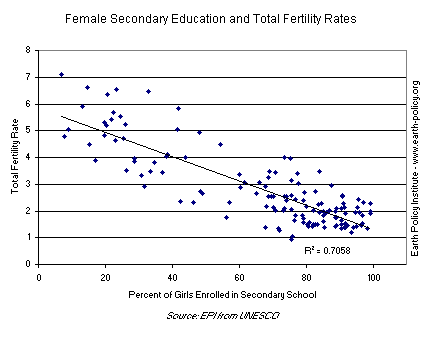 Culture has helped humans conquer the planet - and there are currently over seven billion humans in existence. The average effect of memes on their hosts has generally been pretty positive.
Culture has helped humans conquer the planet - and there are currently over seven billion humans in existence. The average effect of memes on their hosts has generally been pretty positive.However, memes often have a remarkably negative effect on reproductive output. In what is widely known as the "demographic transition" women in more developed countries have fewer babies. Roughly, the richer the country is, the fewer babies are made. The culmination of this effect is seen in Japan - probably the most meme-rich country in the world. There, we see sub-replacement fertility and population decline.
One possible explanation for this involves r/K selection and the idea of a superstimulus. Standard r/K selection theory suggests that organisms may be adapted to respond to increased wealth with greater investments in offspring quality relative to offspring quality - more 'K' and less 'r'. It is clear that r/K selection theory explains some of the reduction in offspring number that is produced by wealth. However, the sub-replacement fertility seen in the real world is pretty clearly maladaptive. A possible explanation is that unusually high levels of wealth could result in a superstimulus and lead to the adaptive mechanism described above operating outside its normal range and malfunctioning.
There are also theories based on memetics. The idea that memes are involved is corroborated by the strong negative correlation between the number of years of education young women receive and the number of children they have. Few things stop your eggs from being fertilized as effectively as a college degree.

The meme for celibacy is transmitted by priests to young boys who have not yet decided what they want to do with their lives. The medium of transmission is human influence of various kinds, the spoken and written word, personal example and so on. Suppose, for the sake of argument, it happened to be the case that marriage weakened the power of a priest to influence his flock, say because it occupied a large proportion of his time and attention. This has, indeed, been advanced as an official reason for the enforcement of celibacy among priests. If this were the case, it could follow that the meme for celibacy could have greater survival value than the meme for marriage. Of course, exactly the opposite would be true for a gene for celibacy. If a priest is a survival machine for memes, celibacy is a useful attribute to build into him. Celibacy is just a minor partner in a large complex of mutually-assisting religious memes.
Specific technologies for sterilizing humans have evolved. Barrier contraceptives prevent sperm from reaching their targets. Chemical contraceptives mess up the female reproductive system, preventing conception. Abortion has become quick and easy - and there's even a "morning after pill". Evolution linked the human reproductive drive fairly strongly to the sex drive. Contraceptives break this link. Men can have sex without investing any resources in parental care. Women can have sex without going through labour and childbirth. Many men and women apparently choose to do this.
Memes whose transmission is vertical with respect to the generations of their hosts can be expected to have interests that are aligned with those of their hosts. Arguably we see such a transmission pattern with some traditional religious systems - with the Amish springing to mind as an example. However in the modern world, advances in communications technologies have led to meme transmission patterns that tend to be horizontal with respect to host generations. In such cases, we can expect to see more parasitic memes thriving - unless increased efforts are put into preventing their spread. However, in the case of contraception, the memes involved seem to be largely unopposed. It is true that some religious factions object to abortion while others discourage use of contraceptives, however overall, the fertility-reducing memes associated with "family planning" face relatively little opposition.
As an example of a sterilization meme, consider the essay Why it is important not to have children from Richard Stallman's personal site. Stallman is clearly a memetic hijacking victim. In his essay he clearly describes the competition between memes and genes and explains why he chose to propagate his memes - rather than his genes.
Memes are sterilizing humans on a massive scale. They also appear to be getting better at it. This leads to the obvious question of what the future holds. Will we see human fertility decline to the point where we see "peak human"?
I think that is the most obvious conclusion - although the supporting reasoning has relatively little to do with existing fertility trends. Instead it seems clear that the future dominant organisms will be engineered. They will, in short, be superintelligent machines. Humans might persist in such a world, but probably only as a very small piece of it. Perhaps their main role will eventually be in populating historical simulations. The machines will trace their ancestry back through us. We will be regarded as their progenitors. Human DNA will probably survive for a long time to come. However it is challenging to imagine a realistic distant future with very many "meat bag" humans in it. The current situation is just a stage the biosphere is going through before the rise of the superintelligent machines.










Elon Musk has subsequently endorsed this idea: https://www.businessinsider.com/elon-musk-reiterates-global-population-is-headed-for-collapse-2019-6
ReplyDelete